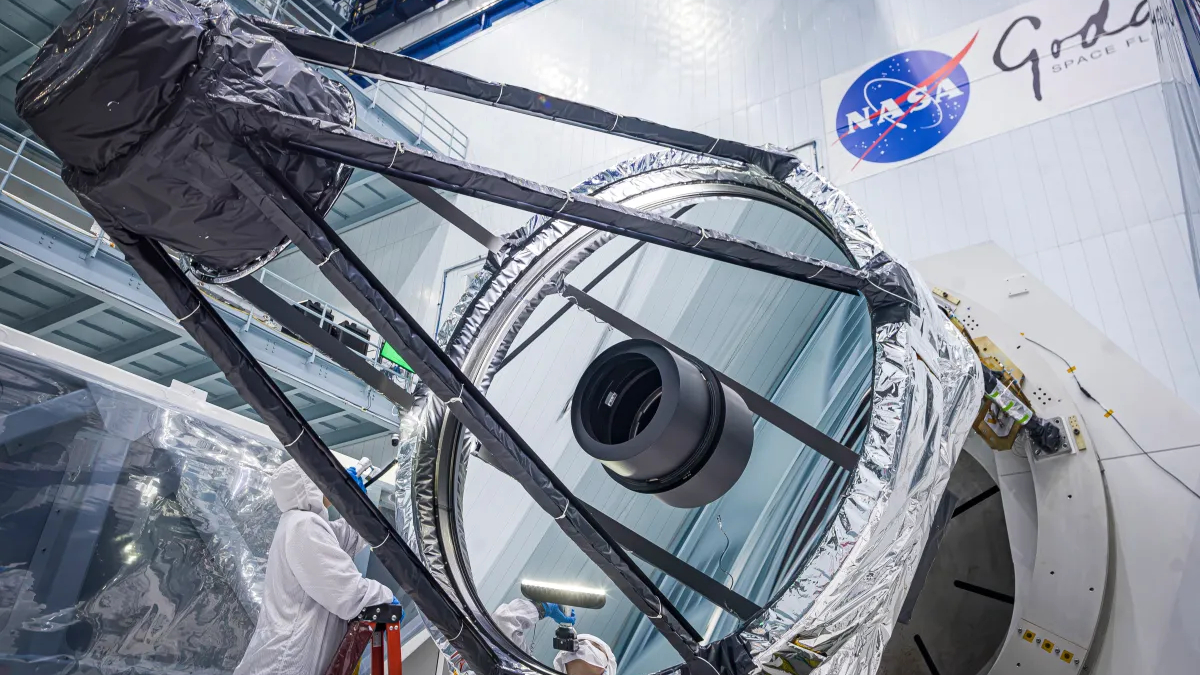
Scientists working on NASA's Nancy Grace Roman Space Telescope have achieved a significant milestone in assembling the next-generation observatory, which aims to address critical questions about dark matter, exoplanets and infrared astrophysics.
The Optical Telescope Assembly, a key component of the Nancy Grace Roman Space Telescope, or Roman for short, was successfully delivered to NASA's Goddard Space Flight Center in Greenbelt, Maryland, in early November from Rochester, New York, where it was designed and built by the company L3Harris Technologies.
This advanced assembly includes a state-of-the-art primary mirror, designed to capture and focus faint infrared light from the distant cosmos, as well as nine additional precision-engineered mirrors. Together with its structural supports and sophisticated electronics, the assembly will serve as the telescope's "eye," enabling groundbreaking observations and unlocking the mysteries of the universe.
The delivery marks a crucial step toward completing the Roman Space Telescope, which is expected to expand our understanding of the cosmos and revolutionize the study of dark energy, galaxy formation, and planetary systems beyond our solar system.
Related: What is the Nancy Grace Roman Space Telescope?
"Projects of this magnitude demand excellence in virtually every aspect," J. Scott Smith, the assembly's telescope manager at NASA Goddard, told Space.com via email. "This drive for perfection is intensified when building and delivering a space telescope that pushes engineering boundaries to answer seemingly impossible scientific questions."
Roman will surpass its predecessor, the Hubble Space Telescope, with its advanced capabilities for conducting large-scale sky surveys.
"Much like a cell phone has multiple cameras to capture a wide angle and zoomed image, Webb and Roman will work together to explore our universe with different views," said Smith, referring to NASA's $10 billion James Webb Space Telescope, which launched in December 2021. "Roman's technology and scientific capabilities will also serve as the next critical step towards the Habitable Worlds Observatory, which would enhance our understanding of the universe even further and advance the search for planets that could support life."

Equipped with a Wide Field Instrument featuring a 300-megapixel infrared camera, Roman will cover a much broader area of the night sky. Additionally, the telescope is designed to operate at extremely low temperatures, minimizing internal noise and making it easier to detect faint, distant objects.
"The wide field of view allows the Observatory to collect in a single image what would take Hubble several hundred, and after accounting for how fast the Roman Observatory can point to a new target, it further improves the efficiency," explained Smith. "One of Roman's main survey campaigns, the High Latitude Wide Area Survey, will cover 2,000 square degrees (about 5% of the sky) in just over seven months. It would take Hubble or Webb hundreds of years to image such a large sky area."
The telescope's coronagraph, which has already been installed, will allow it to block out the bright light from stars, enabling direct observation of faint objects like exoplanets and distant galaxies with greater clarity.
The design and performance of the assembly will play a crucial role in determining the quality of the mission's results, making the manufacturing and testing processes exceptionally rigorous. Achieving success in such a complex project requires flawless alignment of countless elements, despite the inevitable challenges that arise.

"Success requires millions of elements to align perfectly, yet the work is executed by people and machines — both inherently imperfect," Smith said. "Human error, accidents, and mechanical failures are inevitable realities we must contend with. [But] it's not just about preventing mistakes, but about how we respond and recover when they occur. This is where our team truly excelled."
To minimize the likelihood of error, each individual component was meticulously tested before assembly. The entire telescope was then subjected to rigorous tests designed to simulate the intense shaking and vibrations it will endure during launch, ensuring it arrives in its desired orbit intact and functions as intended.
NASA reports that the telescope underwent a month-long thermal vacuum test to ensure it will withstand the temperature and pressure environment of space, while maintaining its own temperature to within a fraction of a degree. This means the telescope will be able to maintain a stable focus to capture its high-resolution images.
This careful coordination and extensive testing is key to ensuring the telescope's performance, especially when it comes to stability. "The Roman telescope represents the pinnacle of telescope stability, a claim substantiated by extensive ground-based testing," Smith added. "To achieve this unprecedented level of stability, we pioneered innovative methods in hardware construction and testing, significantly advancing the state of the art in telescope engineering."
Related: NASA's Roman space telescope gets ready to stare at distant suns to find alien planets
The next steps involve integrating the optical assembly into Roman's instrument carrier, the structural skeleton of the observatory. According to the team, they remain on track for the telescope's highly anticipated launch in early 2027, atop a SpaceX Falcon Heavy rocket.
"A high point of our journey [has been] witnessing the entire telescope come together as an aligned system — a moment that crystallized years of dedication from hundreds of individuals," Smith said. "During this process, the alignment team experienced something truly extraordinary: They were able to look through the telescope in double-pass and see their own reflection. Double-pass is kind of like taking a selfie in a mirror, where you use the telescope to look at itself.
"When I had the opportunity to look through the telescope myself, it was nothing short of a transcendent experience," he continued. "Observing the technician re-imaged with such incredible precision and clarity, reduced to just a few inches in size, was surreal. It was a moment that not only showcased the telescope's extraordinary capabilities but also connected us viscerally to the magnitude of our achievement. This experience went beyond mere scientific accomplishment — it touched upon the very essence of human curiosity and our relentless pursuit to understand the cosmos."







